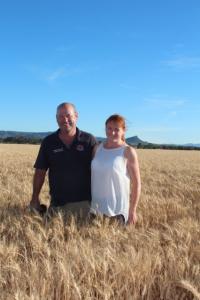Managing climate, managing risk
Susan Findlay Tickner, farmer, Wimmera region of Victoria, Australia: “Climate variability is one of our biggest production challenges. We’re dealing with frost, drought, uncertain rainfall,… having to manage very different rainfall patterns to make the best agronomic decisions.”
Susan and her husband Simon, farm wheat, lentils, barley and canola on their 3,500 hectare property in the Wimmera region of western Victoria.
The region is historically well known for its consistent rainfall of approximately 400 millimetres per year. However, from the late 1990s, along with much of the country, the Wimmera entered a prolonged period of drought. Known colloquially as the millennium drought, between 1998 and 2007 the Wimmera’s average rainfall fell 16 per cent below the 1961 to 1990 average. While rainfall has returned to near-normal, rainfall patterns remain unpredictable.
To maximise production the enterprise has implemented several risk management strategies.
“It has been a process we have undertaken over the last 10 to 12 years,” Susan said.
“We aim to increase productivity by using new grain varieties, variable seeding times and innovative technologies and practices.
“We’ve progressively moved into a full no till inter-row sowing system which maximises water use efficiency and assists with rainfall harvesting. We maintain our stubble to keep moisture in the soil - we don’t till so we don’t lose moisture.”
Susan said the family also optimised the use of fertilizer by measuring nutrient levels with a plan to start with low fertiliser rates and feed the crop as needed through the growing season. This way they don’t apply excessive or unnecessary amounts of fertiliser.
The family stores all grain produced on-farm and has invested in a modern grain storage and logistics operation. At harvest grain is carted directly from the paddock to their own silos, providing flexibility to market the grain when conditions are right to maximise returns over the following 18 months.
But there are still challenges.
“Accurate short term forecasting and monitoring of rain fall events at farm level are critical to maximizing production. We base many of our agronomic decisions on rainfall, such as timely application of fertilizer and crop protection products. Unfortunately, in the Wimmera, these are as unreliable as the weather!,” Susan said.
“Ideally, we would have access to reliable long and short term weather forecasting. We would then know exactly where we are at, at the start of each season, before putting the crop in.
“It makes it hard in a year like this where rainfall has dried up in our region. After excellent seasonal opening rains in April, rainfall has cut off at the beginning of August mid-way through the growing season. We’ve seen no significant rain in September where in parts of New South Wales and even in eastern Victoria it’s a different ball game. Better district forecasting models would help us to plan our year.”
Responding to climate change is just one of the topics up for discussion at the IUCN World Parks Congress, being held in Sydney from 12 to 19 November this year.
Held in a different country every 10 years, the Congress will bring more than 4,000 people together from around the world to discuss inspiring solutions to some of the biggest problems facing our planet.
Read more about Susan’s story on the Climate Kelpie website
See Susan presenting at the ABARES conference







